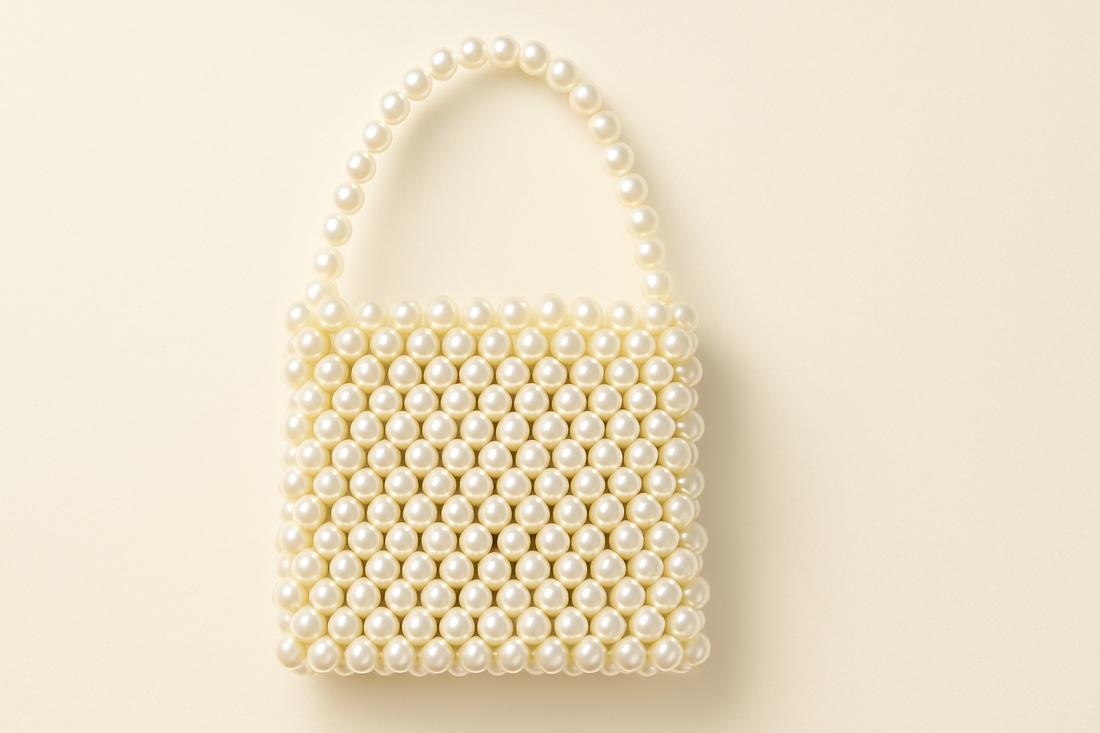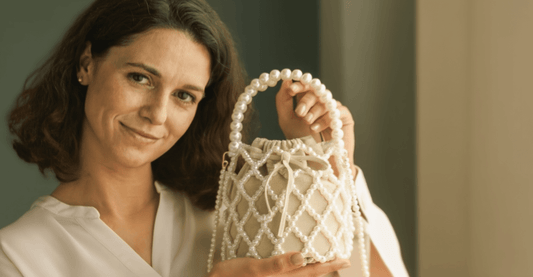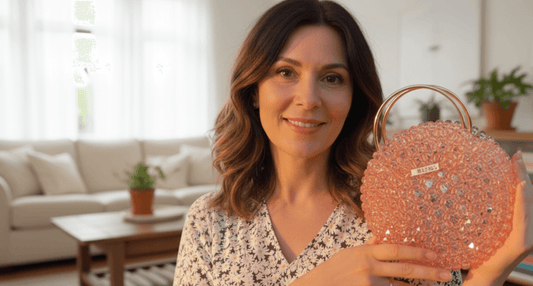How to Make a Bead Purse: Complete DIY Guide for Beginners

How to make a bead purse is one of the most rewarding crafting projects you can undertake, combining creativity, skill development, and the satisfaction of creating a functional accessory that reflects your personal style. Making a bead purse allows you to control every aspect of the design process, from selecting the perfect beads to choosing colors that complement your wardrobe perfectly.
The art of bead purse making has experienced a remarkable revival as more people seek meaningful, handcrafted alternatives to mass-produced accessories. DIY bead purses offer endless possibilities for customization, whether you prefer the elegance of pearl beads, the natural beauty of wooden beads, or the sparkle of glass beads. Each bead purse you create tells a unique story through your choice of materials, patterns, and finishing techniques.
Learning how to make a bead purse requires patience and attention to detail, but the process itself is surprisingly accessible to crafters of all skill levels. With the right materials, basic techniques, and creative vision, you can create bead purses that rival expensive designer pieces while expressing your individual aesthetic. The journey from selecting your first bead to completing your finished bead purse provides both meditative crafting time and practical skills that will serve you well in future projects. 🧵
Chapter 1: Understanding Bead Purse Construction Fundamentals
The foundation of learning how to make a bead purse begins with understanding the basic construction principles that govern all successful bead purse projects. Bead purse making combines traditional textile techniques with decorative beadwork, creating accessories that are both beautiful and functional. The structural integrity of your bead purse depends on proper foundation work, appropriate thread selection, and understanding how beads interact with different base materials.
Bead purse construction typically involves three main components: the foundation fabric or base, the beads themselves, and the connecting materials that hold everything together. The foundation provides the structural support that allows your bead purse to maintain its shape while carrying everyday items. Common foundation materials include canvas, felt, interfacing, and specialized beading fabric, each offering different advantages depending on your specific bead purse design.
Thread selection plays a crucial role in bead purse durability and appearance. Beading thread must be strong enough to support the weight of multiple beads while remaining fine enough to pass through bead holes multiple times. Nymo thread, FireLine, and silk thread are popular choices for bead purse construction, each offering specific benefits for different bead types and construction techniques.
Understanding bead weights and how they affect your bead purse design is essential for creating balanced, comfortable accessories. Pearl beads and wooden beads have different weight distributions that impact how your finished bead purse hangs and feels when carried. Heavier beads require stronger construction techniques and may need additional structural support to prevent sagging or thread breakage.
The beading process itself involves systematic pattern work that builds from the foundation outward. Bead purse patterns can range from simple geometric designs suitable for beginners to complex pictorial representations that challenge experienced crafters. Understanding how to read beading patterns, count beads accurately, and maintain consistent tension are fundamental skills for successful bead purse creation.
Color theory and bead selection significantly impact the visual appeal of your finished bead purse. Beads interact with light differently based on their material, finish, and size, creating varying visual effects within your design. Pearl beads reflect light softly, creating subtle luminosity, while faceted glass beads create sparkling highlights that catch attention.
The finishing techniques used in bead purse construction determine both the professional appearance and long-term durability of your accessory. Proper edge finishing, secure clasps, and reinforced stress points ensure that your handmade bead purse will withstand regular use while maintaining its beauty. Understanding these fundamentals provides the knowledge base necessary for tackling any bead purse project with confidence.
Sizing considerations affect both the construction process and the final functionality of your bead purse. Different sizes require different construction approaches, with larger bead purses needing additional structural support and smaller clutch-style bead purses focusing on precise detail work. Planning your bead purse size from the beginning ensures that your materials, construction time, and finishing techniques align with your intended use.
Essential Materials and Tools for Bead Purse Making
- Beading needles in various sizes are essential for bead purse construction, with size 10-15 needles working best for most bead sizes and threading requirements.
- Beading thread options include Nymo, FireLine, and silk thread, each offering different strengths and working characteristics for various bead purse construction techniques.
- Beads themselves come in countless varieties, with pearl beads, wooden beads, glass beads, and crystal beads being popular choices for bead purse projects.
- Foundation materials such as canvas, felt, or specialized beading fabric provide the structural base that supports your beads and maintains bead purse shape.
- Scissors designed for thread cutting ensure clean cuts that prevent fraying and maintain thread integrity throughout the bead purse construction process.
- Beading hoops or frames help maintain fabric tension while working, making bead placement more accurate and reducing hand fatigue during long crafting sessions.
- Pattern materials including graph paper, colored pencils, and design templates help plan your bead purse layout before beginning the actual beading process.
- Measuring tools such as rulers, measuring tapes, and bead boards ensure accurate spacing and consistent bead placement throughout your bead purse project.
- Storage solutions including bead containers, thread organizers, and project bags keep your bead purse materials organized and prevent loss of small components.
- Finishing supplies such as purse hardware, clasps, chains, and lining materials complete your bead purse and add professional touches to your handmade creation.
- Lighting equipment including task lamps and magnifying glasses reduce eye strain and improve accuracy when working with small beads and intricate patterns.
- Reference materials such as beading books, pattern collections, and online tutorials provide inspiration and technical guidance for bead purse construction techniques.
Step-by-Step Bead Purse Construction Process
- Pattern preparation begins with selecting or creating a design that matches your skill level and desired bead purse style, whether simple geometric patterns or complex pictorial designs.
- Foundation cutting involves measuring and cutting your base material to the correct size, including seam allowances and any structural reinforcement needed for your bead purse design.
- Design transfer uses various methods to mark your pattern onto the foundation material, ensuring accurate bead placement and consistent spacing throughout the construction process.
- Thread preparation includes cutting appropriate lengths, conditioning if necessary, and threading needles with doubled or single thread depending on your chosen construction technique.
- Starting techniques establish secure beginning points for your beading, whether using knots, backstitch anchoring, or other methods that ensure beads remain firmly attached.
- Basic beading stitches such as backstitch, running stitch, and couching create the foundation for attaching beads to your base material in organized patterns.
- Pattern following requires careful attention to design charts, maintaining consistent bead spacing, and regular checking to ensure pattern accuracy throughout the construction process.
- Color transitions within your bead purse design need careful planning to create smooth gradients or sharp contrasts, depending on your intended visual effect.
- Edge finishing techniques secure beads along bead purse edges while creating clean, professional-looking borders that enhance the overall appearance of your finished piece.
- Assembly processes bring together different bead purse components, including front and back panels, sides, and bottom pieces, using appropriate joining techniques.
- Hardware attachment involves securely installing clasps, chains, handles, or other functional elements that make your bead purse practical for everyday use.
-
Final inspection includes checking all bead attachments, testing hardware functionality, and making any necessary adjustments before considering your bead purse complete.

Advanced Techniques and Design Considerations
Creating Complex Patterns and Motifs
Advanced bead purse construction involves mastering complex pattern work that transforms simple bead arrangements into sophisticated artistic statements. Bead purse patterns can incorporate geometric designs, floral motifs, abstract compositions, or even representational imagery that tells specific stories or conveys cultural meanings. The key to successful complex pattern work lies in careful planning, precise execution, and understanding how different bead types interact within your overall design. Don't hesitate to purchase yours here
Pattern scaling becomes crucial when adapting existing designs for different bead purse sizes or when creating original compositions. Beads of varying sizes require different spacing calculations, and patterns that work beautifully with small seed beads may need significant modification when executed with larger pearl beads or wooden beads. Understanding these scaling principles allows you to adapt any pattern to your preferred bead types and bead purse dimensions.
Color gradation techniques create sophisticated visual effects that elevate simple bead purse designs into professional-quality accessories. Gradual color transitions using beads in related hues create depth and movement within your design, while strategic placement of accent colors draws attention to specific pattern elements. Pearl beads work particularly well for subtle gradations, while glass beads offer brilliant color transitions that catch and reflect light beautifully.
Texture mixing within bead purse patterns adds tactile interest and visual complexity that makes your finished piece more engaging. Combining smooth pearl beads with rough-textured wooden beads, or matte finish beads with highly polished varieties creates contrast that enhances the overall design impact. Understanding how different textures work together helps you create bead purses with sophisticated visual depth.
Structural Engineering for Durability
The longevity of your bead purse depends on understanding and implementing proper structural engineering principles throughout the construction process. Bead purse construction must balance aesthetic appeal with practical durability, ensuring that your finished accessory can withstand regular use while maintaining its beautiful appearance. This requires strategic reinforcement of stress points, appropriate thread tension, and understanding how different construction techniques affect long-term durability.
Stress point identification helps you recognize areas of your bead purse that will experience the most wear and tear during use. Handle attachment points, clasp areas, and bottom corners typically bear the most stress and require additional reinforcement to prevent premature failure. Planning for these stress concentrations from the beginning of your project ensures that your bead purse remains functional and beautiful for years to come.
Thread path optimization involves planning bead attachment routes that distribute weight evenly and minimize thread crossing that can create weak points. Understanding how thread moves through your bead arrangement helps you create construction sequences that maximize strength while maintaining design integrity. This is particularly important when working with heavier beads like large wooden beads or dense pearl beads.
Reinforcement techniques include strategic placement of additional threads, backing materials, or structural elements that strengthen high-stress areas without compromising the visual appeal of your bead purse. These reinforcements should be nearly invisible in the finished piece while providing the structural support necessary for long-term durability.
Professional Finishing Methods
Professional finishing techniques distinguish handmade bead purses from amateur craft projects, creating accessories that rival commercially produced pieces in both appearance and functionality. These advanced finishing methods require additional time and skill but result in bead purses that look and feel like luxury accessories. Understanding and implementing these techniques elevates your craftsmanship to professional levels.
Edge treatment options extend beyond simple hemming to include piped edges, bound finishes, and decorative trim applications that complement your bead work while providing clean, durable borders. The choice of edge treatment should harmonize with your overall design while providing the structural integrity necessary for regular use. Pearl beaded edges create elegant formal finishes, while wooden bead trim offers casual sophistication.
Lining installation transforms the interior of your bead purse from rough construction materials into smooth, professional-looking storage space. Quality lining materials protect your belongings while hiding construction details and adding structural support to the finished piece. The lining fabric choice should complement your bead work colors while providing appropriate functionality for your intended use.
Hardware integration requires precise measurement and installation to ensure that clasps, handles, and other functional elements work smoothly while maintaining the aesthetic integrity of your bead purse design. Professional hardware installation techniques create seamless transitions between decorative bead work and functional elements.
Chapter 5: Troubleshooting and Maintenance
Common Construction Problems and Solutions
Bead purse construction presents unique challenges that even experienced crafters encounter regularly. Understanding common problems and their solutions helps you complete projects successfully while developing the skills necessary for increasingly complex bead purse designs. Thread tension issues represent one of the most frequent problems in bead purse construction, affecting both the appearance and durability of your finished piece.
Thread tension problems manifest as puckering, loose beads, or distorted patterns that detract from your bead purse appearance. Consistent tension requires practice and attention throughout the construction process, as variations can accumulate and become more noticeable as work progresses. Developing good tension habits early in your bead purse making journey prevents many construction problems and creates more professional-looking results.
Bead selection mistakes can significantly impact your bead purse construction process and final results. Beads with irregular holes, varying sizes within the same batch, or incompatible materials can cause threading difficulties, pattern distortions, or structural weaknesses. Learning to evaluate bead quality before beginning your project saves time and frustration while ensuring better final results.
Pattern alignment challenges occur when bead placement gradually shifts from the intended design, creating distorted or asymmetrical results. Regular checking against your pattern template, using measuring tools, and maintaining consistent working methods help prevent alignment problems that can require extensive correction work.
Thread breakage during construction can seem like a major setback, but proper repair techniques allow you to continue work without compromising the integrity of your bead purse. Understanding how to secure broken threads, add new working thread, and hide joining points ensures that thread breakage becomes a minor inconvenience rather than a project-ending problem.
Maintenance and Care Instructions
Proper maintenance extends the life and beauty of your handmade bead purse while preserving the investment of time and materials you've put into its creation. Bead purse maintenance requirements vary based on the materials used, construction techniques employed, and frequency of use, but understanding general care principles helps you develop appropriate maintenance routines for your specific pieces.
Cleaning techniques for bead purses must consider both the beads themselves and the foundation materials used in construction. Pearl beads require gentle cleaning with soft cloths and minimal moisture, while wooden beads may need specialized wood care products to maintain their finish and prevent cracking. Understanding the specific needs of your bead materials ensures that cleaning enhances rather than damages your bead purse.
Storage considerations protect your bead purse from damage during periods of non-use while maintaining its shape and preventing bead damage. Proper storage involves protection from moisture, extreme temperatures, direct sunlight, and physical pressure that could distort the bead purse shape or damage individual beads. Developing good storage habits preserves your bead purses for years of enjoyment.
Repair techniques for damaged bead purses allow you to address problems before they become major issues requiring complete reconstruction. Understanding how to replace individual beads, repair thread damage, and address hardware problems helps you maintain your bead purses in excellent condition throughout their useful life.
Quality Control and Assessment
Quality assessment techniques help you evaluate your bead purse construction progress and identify areas needing improvement before completion. Regular quality checks throughout the construction process allow you to address problems while they're still manageable rather than discovering major issues after completion. Developing critical evaluation skills improves both your current project and your future bead purse making abilities.
Construction consistency evaluation involves comparing different sections of your bead purse to ensure uniform bead spacing, thread tension, and pattern accuracy throughout the piece. Consistency creates professional-looking results while inconsistency reveals areas needing additional attention or correction work.
Durability testing appropriate for bead purse construction includes gentle stress testing of construction joints, hardware functionality, and thread security without damaging your finished piece. Understanding how to evaluate durability helps you identify potential problems before they occur during normal use.
Final inspection procedures ensure that your completed bead purse meets your quality standards and functions properly for its intended use. Comprehensive final inspection includes checking all construction details, testing hardware operation, and ensuring that the finished piece meets your original design goals and quality expectations.
FAQ How to Make a Bead Purse
What materials do I need to make a bead purse?
To make a bead purse, you'll need beads (such as pearl beads, wooden beads, or glass beads), beading needles, strong thread (Nymo or FireLine), foundation fabric, scissors, and basic sewing supplies. Additional materials include purse hardware like clasps and handles, lining fabric, and pattern materials. The specific bead types and quantities depend on your chosen design and purse size.
How long does it take to make a bead purse?
The time required to make a bead purse varies significantly based on design complexity, size, and your experience level. Simple bead purse projects may take 20-40 hours, while complex designs with intricate patterns can require 100+ hours of work. Beginners should expect longer construction times as they develop skills and familiarity with bead purse construction techniques.
Can beginners successfully make a bead purse?
Absolutely! Beginners can successfully make a bead purse by starting with simple patterns and gradually building skills. Choose larger beads like wooden beads for easier handling, select straightforward geometric patterns, and focus on mastering basic techniques before attempting complex designs. Many beginner-friendly bead purse patterns are available to help you get started.
What's the best type of thread for bead purse construction?
The best thread for bead purse construction depends on your bead types and construction technique. Nymo thread works well for most projects, Fire Line offers exceptional strength for heavy beads, and silk thread provides smooth handling for delicate work. Choose thread that passes easily through your beads while providing adequate strength for your bead purse design.
How do I fix mistakes in my bead purse construction?
Bead purse mistakes can often be corrected without starting over. For individual misplaced beads, carefully remove and reposition them. Pattern errors may require removing several rows of beads to correct alignment. Thread breaks can be repaired by securing loose ends and adding new working thread. Prevention through careful planning and regular checking minimizes correction work needed.
Conclusion
Learning how to make a bead purse opens up a world of creative possibilities that combines traditional craftsmanship with personal expression. The journey from selecting your first beads to completing a finished bead purse provides both meditative crafting time and valuable skills that will serve you throughout your creative endeavors. Bead purse making offers the unique satisfaction of creating functional art that reflects your individual style while developing patience, precision, and artistic vision.
The comprehensive approach outlined in this guide provides the foundation knowledge necessary for successful bead purse construction, from understanding basic materials and tools to mastering advanced techniques and professional finishing methods. Whether you choose to work with elegant pearl beads, natural wooden beads, or sparkling glass beads, the fundamental principles remain consistent while allowing for infinite creative variation.
The technical aspects of bead purse construction – proper thread selection, tension control, pattern following, and structural engineering – ensure that your handmade accessories are not only beautiful but also durable enough for regular use. Understanding these technical requirements helps you create bead purses that rival commercially produced pieces while expressing your unique aesthetic vision.
The troubleshooting and maintenance information provided helps you address common construction challenges and preserve your finished bead purses for years of enjoyment. Developing good construction habits, quality control practices, and maintenance routines ensures that your investment of time and materials results in lasting, beautiful accessories.
Bead purse making connects you to centuries of traditional craftsmanship while allowing for contemporary innovation and personal creativity. Each bead purse you create tells a story through your choice of materials, colors, patterns, and finishing details. The skills you develop through bead purse construction transfer to other beading and textile projects, building a foundation for lifelong creative pursuits.
As you embark on your bead purse making journey, remember that each project teaches valuable lessons and builds skills for future endeavors. Start with simple designs to master basic techniques, then gradually challenge yourself with more complex patterns and advanced construction methods. The combination of patience, creativity, and technical skill required for successful bead purse construction provides rewards that extend far beyond the finished accessory – you're developing abilities that will enrich your creative life for years to come. 🧵✨Don't hesitate to purchase yours here
No comments









0 comments